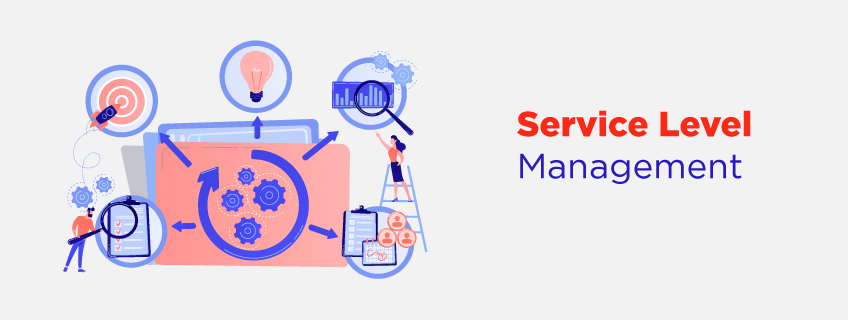Service Level Management (SLM) is an essential component of IT Service Management (ITSM) that guarantees IT services assist and support a company’s business goals. SLM is a strategic approach focusing on defining, negotiating, and managing service levels agreed upon between the service provider and the customer. It is a guide for setting goals, tracking progress, and enhancing service delivery.
Goals Of Service Level Management
The primary goals of SLM revolve around establishing and maintaining mutually beneficial agreements (Service Level Agreements, or SLAs) between the IT service provider and its customers. These agreements outline the quality, availability, and responsibilities of the services provided. Key goals include:
Defining Service Level Agreements (Slas): SLM aims to collaboratively define SLAs that clearly articulate the scope, quality, and responsibilities for each IT service provided. To make sure everyone is on the same page, this process requires extensive negotiations.
Monitoring And Reporting Performance: SLM establishes mechanisms for monitoring service performance against agreed-upon SLAs. It involves setting up metrics and Key Performance Indicators (KPIs) to measure factors such as uptime, response times, and service availability. Regular reporting ensures transparency and accountability.
Continuous Improvement: One of the core goals of SLM is to facilitate continuous service improvement. By analyzing performance data and customer feedback, SLM identifies areas for enhancement and recommends changes to processes, resources, or technologies to optimize service delivery.
Aligning IT Services With Business Needs: SLM aims to bridge the gap between IT services and business requirements. By understanding business priorities and goals, SLM ensures that IT services contribute effectively to the overall success and competitiveness of the organization.
Methods And Processes In Service Level Management
SLM encompasses several key methods and processes designed to achieve its goals effectively:
Service Level Agreement (Sla) Management:
Definition And Negotiation: SLM begins with defining SLAs based on business needs and IT capabilities. Negotiations involve stakeholders from both IT and business units to ensure realistic and achievable targets.
Documentation: Formal SLAs are documented, detailing service scope, performance metrics, responsibilities, escalation procedures, and governance mechanisms.
Service Level Monitoring And Reporting:
Monitoring Tools and Technologies: SLM employs monitoring tools to track service performance in real time. These tools capture data on service availability, response times, incident resolution, and compliance with SLA targets.
Performance Analysis: Data collected is analyzed to identify trends, potential issues, and areas for improvement. Reports are generated regularly to provide stakeholders with insights into service performance and adherence to SLAs.
Service Review And Improvement:
Review Meetings: Regular service review meetings are conducted between IT service providers and customers. These meetings assess SLA performance, discuss challenges, and prioritize improvement initiatives.
Continuous Improvement: Based on review outcomes and analysis, SLM drives continuous improvement initiatives. These may include process optimizations, technology upgrades, skills development, or adjustments to service delivery strategies.
Relationship Management:
Customer Relationship Management: SLM fosters strong relationships with customers through proactive communication, responsiveness to issues, and alignment with their evolving needs.
Vendor Management: In cases where IT services involve external vendors or partners, SLM oversees vendor performance and ensures adherence to contracted SLAs.
Challenges In Implementing SLM
Implementing effective SLM practices can present several challenges for organizations:
Complexity In SLA Definition: Defining comprehensive SLAs that accurately reflect both technical capabilities and business expectations can be challenging, requiring input from diverse stakeholders.
Monitoring And Reporting: Ensuring consistent and accurate monitoring of service performance across diverse IT environments may require investments in monitoring tools and skilled resources.
Cultural Alignment: Achieving cultural alignment between IT teams and business units is crucial for successful SLM implementation, as it impacts collaboration and mutual understanding.
Managing Change: Implementing SLM often involves organizational change, including new processes, roles, and responsibilities, which may face resistance or require extensive training and support.
Benefits Of Effective SLM
Despite these challenges, organizations that successfully implement SLM stand to gain significant benefits:
Improved Service Quality And Reliability: SLM ensures that IT services meet agreed-upon standards of quality, reliability, and performance, enhancing user satisfaction and productivity.
Enhanced Customer Satisfaction: Clear SLAs and reliable service delivery contribute to improved customer satisfaction and loyalty.
Operational Efficiency: SLM promotes efficient resource allocation, reduces downtime, and minimizes service disruptions through proactive monitoring and timely interventions.
Business Alignment: By aligning IT services with business goals, SLM helps organizations leverage technology to achieve strategic objectives and gain competitive advantage.
Continuous Improvement: SLM fosters a culture of continuous improvement, driving innovation and responsiveness to evolving business and technological landscapes.
Conclusion
Lastly, IT service management’s Service Level Management (SLM) component is essential for helping businesses match IT services with business requirements, set clear expectations using service level agreements (SLAs), keep a close eye on performance, and push for constant improvement. Focusing on goals and adopting effective procedures and processes helps firms overcome problems, reap benefits, and improve service delivery and customer satisfaction.
